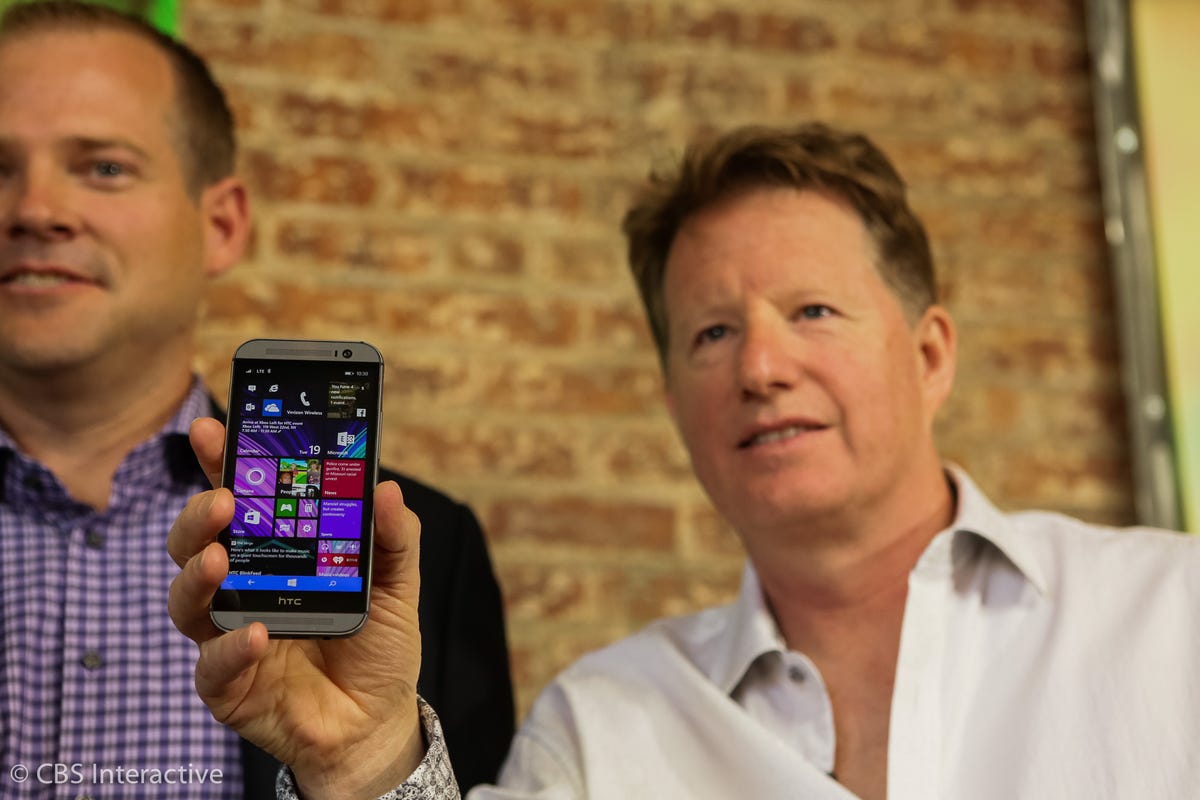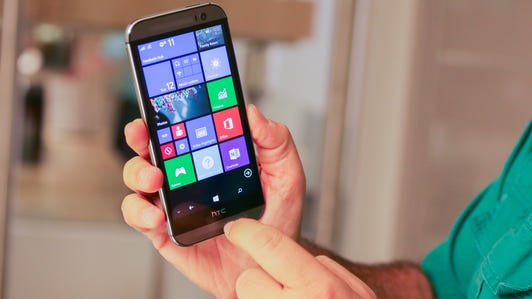
CNET/Sarah Tew
Rival Android could be the cavalry coming to the rescue of Windows Phone, in Microsoft’s latest maneuver to advance its smartphone operating system.
The underlying notion is this: Microsoft wants to make it easier to introduce devices that use the Windows Phone software. That was the message delivered this week’s announcement of the HTC One M8 for Windows Phone.
Specifically, Microsoft has tweaked its Windows Phone 8.1 software so that hardware makers can lean on the hardware and reference designs they’re already using to build devices for Android-based phones in order to build a Windows Phone device.
“We wanted handset makers like HTC to be able to leverage their engineering investment and provide them with a real choice,” said Darren Laybourn, vice president of engineering for Microsoft in an interview following the launch of the HTC One M8 for Windows. “We feel the software should be the differentiator and not the hardware.”
For four years Microsoft’s Windows Phone smartphone operating system has limped along, trying to gain traction against the much more popular Apple iOS and Google Android devices. But Windows Phone handsets remain niche products. In fact, they only garnered about 2.5 percent of the worldwide smartphone market in the second quarter of 2014, according to IDC.
Microsoft has struggled to convince hardware partners to make phones running the Windows Phone operating system in what has turned into a chicken-and-egg scenario. Device makers don’t want to dedicate resources to building a Windows Phone because there are so few customers. But without the devices — especially iconic ones that offer cutting edge components and technology — the operating system will never gain popularity among customers.
Management knows that Microsoft’s mobile ambitions are doomed if it can’t break that pattern. The solution depends on finding a way to get device makers other than Nokia, whose handset operations Microsoft acquired earlier this year for more than $7 billion, to build high-end smartphones using Windows Phone.
With the release of the latest software, Windows Phone 8.1, and now the launch of the HTC One M8 for Windows , Microsoft has come up with a new approach that could point the way past this dilemma.
“Ideally, I’m sure that Microsoft wants HTC, Samsung and others to produce exclusive designs for their software,” said Ross Rubin, principal analyst at Reticle Research. “But I think they recognize the market reality now. And they’re willing to let dedicated hardware go to get more high-end Windows Phone smartphones on the market.”
HTC One M8 for Windows product photos






+32 more
Switching strategies
Microsoft’s Laybourn said the company had begun tweaking the Windows Software to adapt to different hardware designs even before starting work with HTC. For instance, Windows Phone 8.1, launched in the spring, offers redesigned software keys that strip away the old hard buttons on the bottom of the device, replacing them with “soft keys” that pop up at the bottom of screen.
He said there are now 14 devices in Microsoft’s reference design program expected to wind up as real products in the next six months. Some will use Android hardware designs reconfigured slightly to work with the Windows Phone software.
This strategy makes sense for handset makers. Previous versions of Windows Phone forced them to build hardware from scratch. In addition to supporting two reference designs, which means handling two separate component supply chains, it also meant developing separate marketing budgets for each device.
For a company like HTC, which is already struggling to keep up with the massive marketing budgets of Apple and Samsung, this is a huge barrier. Being able to leverage the existing brand recognition of the HTC One series of devices and being able to market both an Android and a Windows Phone version of the latest flagship device in that family can save the company millions in marketing dollars.
“HTC has never been able to compete on marketing spend,” Rubin said. “So optimizing the opportunity to build on the marketing it has already done with the Android version of the One M8 makes a lot of sense.”
What’s more, the designs and specifications used to build Android devices are often a generation ahead of what’s used in Windows Phone devices, Rubin added. This allows a company like HTC to build a truly high-end smartphone with the latest specifications.
Jason Mackenzie, president of HTC Americas, said during the presentation of the new device on Tuesday that the HTC One M8 for Windows marked “the first time a smartphone manufacturer has launched an iconic device on multiple operating systems without making any compromises.”


CNET/Sarah Tew
In an interview, McKenzie acknowledged that it was difficult to build a flagship phone around the previous versions of Windows Phone. And he said that when it came to the overall Windows Phone line-up, he saw a gap.
“When you look at all of the available Windows Phones, there isn’t a real premium smartphone that matches what’s offered on Android,” he said. “When we’re announcing a flagship device, it’s on Android.”
But he said that HTC feels it’s important to give consumers more choices. And even though Microsoft’s Windows Phone market share is just that tiny, 2.5 percent sliver, Mackenzie said that it’s wise to keep it as an alternative to Google Android.
Still, in spite of a relationship with Microsoft that dates back to the old PocketPC and the original Windows Mobile smartphones, HTC had not introduced a new Windows Phone since the fall of 2012. Part of the reason for the lag was Microsoft’s relationship with Finnish device-maker Nokia, Mackenzie said. A year ago, Microsoft announced its plans to buy Nokia for €5.44 billion, or $7.2 billion.
“We were waiting to see how the relationship would take shape,” he said. “Then there was the acquisition and a regime change at Microsoft. We weren’t sure what their strategy was going to be.”
Microsoft CEO Steve Ballmer left his post in February and was replaced by Satya Nadella. After months of speculation about Microsoft’s intent, Nadella’s plans for the former Nokia unit and for Windows Phone more generally are coming into focus. Last month, the company announced it will be laying off 18,000 employees, most from Nokia. The decision suggests that Microsoft won’t rely on only Nokia hardware to drive its mobile strategy. The company still needs partners, like HTC.
“Microsoft needs someone else to build the hardware other than relying on the in-house Nokia,” said Roger Entner, lead analyst at Recon Analytics.
Maribel Lopez, head of Lopez Research, agrees. She said that Nokia makes beautiful phones but it will take much more to broaden “ecosystem support” for Windows Phone.
“And that’s what Microsoft needs to make Windows Phone a success,” she said. “It needs to get the benefit of scale with parts and processors to lower the cost to make these phones.”
The stage is set
Microsoft and HTC executives met in January at the Consumer Electronics Show to discuss the two companies’ relationship. It quickly became clear that the two sides could work together to bring the new Windows Phone 8.1 to existing Android hardware being used on HTC’s flagship device.
Laybourn said that Terry Myerson, Microsoft’s executive vice president of operating systems, met with HTC CEO Peter Chou. But the dialogue quickly included the rest of the leadership teams from both companies — including executives from Verizon Wireless. Laybourn said that Microsoft didn’t see a gap per se at the high end of the Windows Phone market. But it was also clear that Microsoft needed to attract more handset makers and make it easier for them to deploy the operating system.
Meanwhile, Verizon saw the same gap in hardware that HTC saw.
“We realized at the end of 2013 that when we were selecting devices for the 2014 lineup that there were gaps in the market for Windows Phone, particularly at the high end,” Jeff, Dietel, vice president of marketing operations at Verizon Wireless said in an interview.


Sarah Tew/CNET
Verizon currently sells the Nokia Lumia Icon and the Nokia Lumia 928. Dietel acknowledged these are great devices, but he said the HTC One franchise is in a different category among Verizon subscribers.
“HTC has been more synonymous with material fit and finish, as well as just really good design,” he said. “Nokia offers terrific hardware, but HTC is just more established in the US in terms of momentum.”
He added that Verizon customers really wanted more choices when it came to smartphones. Not only did they want more hardware choices among Android devices, but he said customers want more software choices, too.
While HTC and Verizon have harped on this notion that consumers are clamoring for more choices, one could argue that they are actually being served well enough by Google Android and Apple iOS, which combined account for 96.4 percent of the market, according to IDC. What is more likely is that handset makers and the carriers themselves like having more choices.
“Windows Phone has a niche audience,” Reticle Research’s Rubin said. “But what it comes down to is that handset makers like having a hedge. They are uncomfortable being beholden to Google or Apple. They want to keep their options open.”
With this latest effort and thanks to efforts by Qualcomm, which has also worked closely with Microsoft to make sure its processors can run on both Windows phone and Android handsets, it could be easier and more cost effective to build devices for each platform using the same hardware.
“There’s been a lot of talk throughout the years of creating a dual-boot phone, which is essentially a single device that can run Android or Windows,” Laybourn said. “So it’s not like we had an epiphany about all this. But we did see an opportunity, and we did the work to make it possible.”
Asked if he expected more high-end devices to come out that use the same hardware as Android phones, Laybourn chuckled.
“I sure hope so,” he said.



